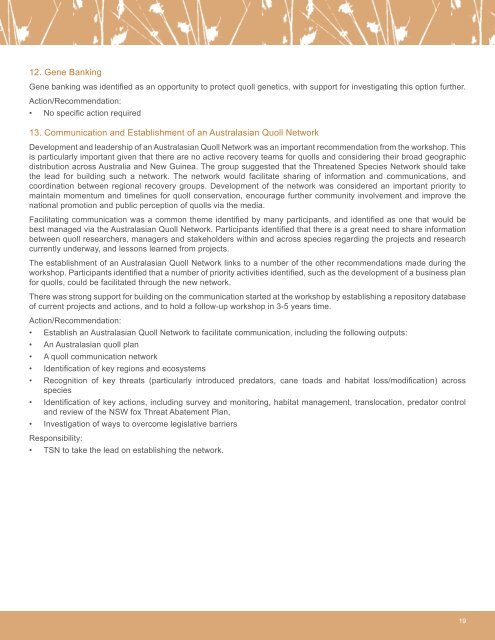Proceedings of the WWF-Australia Quoll Workshop
Proceedings of the WWF-Australia Quoll Workshop
Proceedings of the WWF-Australia Quoll Workshop
You also want an ePaper? Increase the reach of your titles
YUMPU automatically turns print PDFs into web optimized ePapers that Google loves.
12. Gene BankingGene banking was identified as an opportunity to protect quoll genetics, with support for investigating this option fur<strong>the</strong>r.Action/Recommendation:• No specific action required13. Communication and Establishment <strong>of</strong> an Australasian <strong>Quoll</strong> NetworkDevelopment and leadership <strong>of</strong> an Australasian <strong>Quoll</strong> Network was an important recommendation from <strong>the</strong> workshop. Thisis particularly important given that <strong>the</strong>re are no active recovery teams for quolls and considering <strong>the</strong>ir broad geographicdistribution across <strong>Australia</strong> and New Guinea. The group suggested that <strong>the</strong> Threatened Species Network should take<strong>the</strong> lead for building such a network. The network would facilitate sharing <strong>of</strong> information and communications, andcoordination between regional recovery groups. Development <strong>of</strong> <strong>the</strong> network was considered an important priority tomaintain momentum and timelines for quoll conservation, encourage fur<strong>the</strong>r community involvement and improve <strong>the</strong>national promotion and public perception <strong>of</strong> quolls via <strong>the</strong> media.Facilitating communication was a common <strong>the</strong>me identified by many participants, and identified as one that would bebest managed via <strong>the</strong> Australasian <strong>Quoll</strong> Network. Participants identified that <strong>the</strong>re is a great need to share informationbetween quoll researchers, managers and stakeholders within and across species regarding <strong>the</strong> projects and researchcurrently underway, and lessons learned from projects.The establishment <strong>of</strong> an Australasian <strong>Quoll</strong> Network links to a number <strong>of</strong> <strong>the</strong> o<strong>the</strong>r recommendations made during <strong>the</strong>workshop. Participants identified that a number <strong>of</strong> priority activities identified, such as <strong>the</strong> development <strong>of</strong> a business planfor quolls, could be facilitated through <strong>the</strong> new network.There was strong support for building on <strong>the</strong> communication started at <strong>the</strong> workshop by establishing a repository database<strong>of</strong> current projects and actions, and to hold a follow-up workshop in 3-5 years time.Action/Recommendation:• Establish an Australasian <strong>Quoll</strong> Network to facilitate communication, including <strong>the</strong> following outputs:• An Australasian quoll plan• A quoll communication network• Identification <strong>of</strong> key regions and ecosystems• Recognition <strong>of</strong> key threats (particularly introduced predators, cane toads and habitat loss/modification) acrossspecies• Identification <strong>of</strong> key actions, including survey and monitoring, habitat management, translocation, predator controland review <strong>of</strong> <strong>the</strong> NSW fox Threat Abatement Plan,• Investigation <strong>of</strong> ways to overcome legislative barriersResponsibility:• TSN to take <strong>the</strong> lead on establishing <strong>the</strong> network.19
















